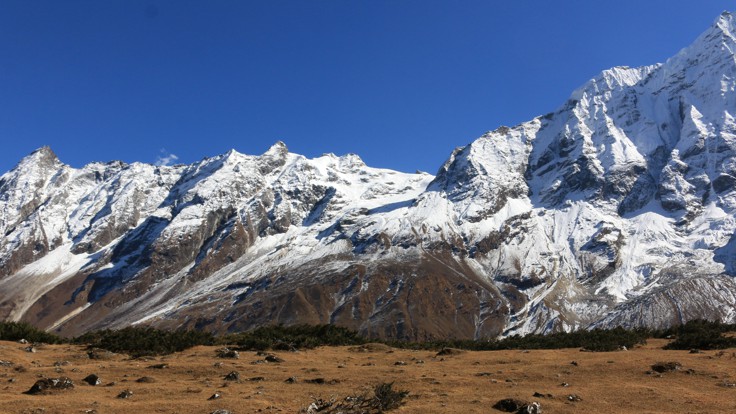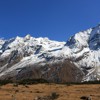Manaslu Circuit - 13 Days
Unknown
Since 2018, HoneyGuide has worked with over 1000 independent/group trekkers, 200+ Lodges and 230+ Local Guides/Porters in the Everest Region.
As a concierge, HoneyGuide will:- Answer your queries and help you make an itinerary as per your budget, preference and time.
- Recommend and help you book Flights, Guides/ Porter and Lodges in every night stop at best rates.
- Full trail support- If any changes occur, we will change your scheduled bookings for free.
We are featured by
HIGHLIGHTS
- Breathtaking Mountain views of Mt. Himalchuli (7,893 m), Manaslu (8,156 m), Shringi Himal (7,161 m), Ganesh Himala II (7,118 m).
- Wide variation of scenery, culture and wildlife, ranging from subtropical jungle to Larke pass (5,100 m).
- Comparatively remote and less commercialized than other trekking trails.
- Options to do epic side trips like Manaslu Base Camp, Tsum Valley, etc.
QUICK FACTS
- Difficulty LevelHard
- Total Length138 km
- Highest Altitude5,135 meters
- Elevation Profile
- Start locationArughat/ Soti Khola
- Finish locationChyamche
- PermitsACAP, MCAP, Restricted Area Permit
- Best SeasonAnytime Except Jan/Feb and May-Aug
DAY TO DAY ITINERARY
- Kathmandu
(1,400 m)
- Arughat Bazaar
(519 m)
- Soti Khola
(595 m)
- Soti Khola
(595 m)
- Machha Khola
( m)
- Machha Khola
( m)
- Jagat
(1,270 m)
- Samagaon
(3,528 m)
- Samdo
(3,870 m)
- Dharmashala
(4,496 m)
- Dharmashala
(4,496 m)
- Larkya La
( m)
- Bhimtang
(3,708 m)
DESCRIPTION
Manaslu Trek is the ultimate trek with a perfect blend of sceneries, culture, adventure, wildlife, and what makes it extra special is the isolated touch to it! During this trek, you will circuit World’s eighth highest mountain ‘Manaslu’ (8163m), experience the local culture through the remote villages, cross the high Larke pass (5100 m), walk across crazy suspension bridges along Buri Gandaki river and countless waterfalls, enjoy scenic mountain views and encounter diverse range of flora and fauna all along. Certainly a great alternative to Annapurna Circuit trek, with so much similarity and less commercialization.
Best time to go: : Anytime except Jan-Feb and May-Aug.
Getting to the start point: Your entry point is the Newar town of Arughat. You can get to this place either by jeep (6 hours) or bus (8 hours). This is the best place where you can sort your last minute problems like banks/ ATM for cash, equipment’s (batteries), stationeries, toilet papers and other tidbits that you have missed out. You can also catch a bus from the far end of the town to Soti khola to save a day. This is the next town which is a day hike away. Buses will be available from early morning up to 2 in the afternoon.
The exit point for Manaslu Trek is Dharapani (the roads from Annapurna Circuit merges here)/ But you can choose to walk up to Besi Sahar (3 more days) and end it there as well. Jeep service is also available from this point on which can take you to Besi Sahar in about 3 hours.
Permits:
1.Restricted Area Permit: US$ 70 per week (was $50 in 2011) + $10 per day extra. First check is at Jagat and last check Dharapani. You’ll probably need more than 7 days to get from place to place.
2.Manaslu Conservation Area Project (MCAP) permit: NRs. 2,000 (approx 20 Euro or US$30)
3.Annapurna Conservation Area Project (ACAP) per: US$10mit: NRs. 2,000 (approx 20 Euro or US$30)
You cannot do this trek alone. The rule suggests a minimum of 2 people and a guide/porter. If you need help with selecting experienced guides, see our guide listing: https://honeyguideapps.com/guides
Accommodation: The trek is completely a tea house trek now, with an exception that you might have to sleep in a tent in Dharamshala (which is managed b the tea house there itself). The lodges are run by local communities and the rooms are pretty basic with a decent toilet. Please do not seek for luxury lodges as you will not find one. Lodges have hot shower facilities available but you will be charged some extra bucks for it.
Network Information: If you are wondering which network kicks off well in the Manaslu trek, CDMA networks are preferred over NTC and NCell. Most locals use CDMA phones. One thing you should know is that CDMA networks cannot be accessed through all mobile phones. If this is the case for you, then you will have to buy a phone in Kathmandu itself as it comes very cheap.
Other things to be careful about:
- 1.Altitude can be a risk factor. Please make sure you take necessary precautions, stay hydrated and acclimatize after each 1000 meters elevation gain.
- 2.The road construction has started to connect with the borders of China, so that might mean dusty roads and some not so fun sight.
- 3.The trails aren’t very well marked. Be careful. So, do not travel alone.The trails can be tricky when wet or when there is snow, good boots suggested. There are several landslide and rockfall areas in the trail. Not all places have charging facilities for phones. Carrying a power bank or solar charger for cell phones is highly recommended.
- 4.Sanitation is not too amazing. Water Filters will be great to have.
- 5.It is a good idea to call in advance to make a booking, the lodges are few and far and can get real crowded real fast.
Also, Read this blog about 8 things to know before going to Manaslu Trek for more information: https://honeyguideapps.com/blog/8-things-to-know-before-going-to-manaslu-circuit-trek
Best Side Trips:
If the time permits, here’s a list of amazing side trips that you can do during Manaslu Trek for a better experience.
1. Tsum Valley
2. Manaslu Base Camp (4848 m)
3. Serang Gompa (3100 m)
4. Hinang Gumba (3100 m)
5. Birendra lake (3620)
6. Kalmachum Lake (3800 m)
Read this blog o Best Side trips of Manaslu Circuit Trek to know more about these side trips: https://honeyguideapps.com/blog/best-side-trips-of-manaslu-circuit-trek
Notes: If you wish to go on this trek, please fill the inquiry form and we will help you plan your trek according to your preference: https://honeyguideapps.com/onboarding-form
FAQS
Traveling to the mountains poses some inherent risks. As such, the best strategy is to prepare for the worst and then hope for the best.
PRE-EXISTING CONDITIONS
The first thing to keep in mind is to see if you have pre-existing conditions that could cause complications at high altitudes. Specifically, suppose you have sickle cell disease, pulmonary hypertension, obesity hypoventilation syndrome, or congenital heart problems. In that case, we highly recommend you consult with a qualified physician before planning a trip to the mountains. Read more.
ALTITUDE-ILLNESS
Given the low amount of oxygen at high altitudes, a sensible ascent is essential to give your body the time to acclimate to the thin air. Failure to do so can lead to your lungs or brain filling up with water leading to death in some cases. The key is not to climb more than 500 meters in one day once you pass the 2,500 meters mark. Read more.
ENVIRONMENTAL HAZARDS
Given the extreme weather in the high mountains, proper gear and regimen must have a safe and comfortable tour. The three most important things that you have to prepare for are cold, snow, and radiation. As such, invest in the right sunglasses, sunscreen, boots, and clothing. Read more.
TRAVEL INSURANCE
We highly recommend everyone get travel insurance covering high altitude evacuation before leaving on a trek to the high mountains. Global Rescue and World Nomads are both highly recommended. For Nepali travelers, please note that insurance that covers helicopter rescue is not available as of now. As such, please be careful while planning your tour and only work with companies that can provide timely evacuation service if needed.
RESCUE AND EMERGENCY
As health facilities are limited in the mountains, a helicopter's evacuation is usually the only option during an emergency. As such, the right insurance provider is essential. If you are not buying insurance for some reason, please ensure that there is someone in Kathmandu who can coordinate payments for a helicopter rescue. Here are some other contacts that might come in handy during an emergency. If you still have questions, please feel free to call / whatsapp us at +977-9801916215 or email Ashish at nectar@honeyguideapps.com
HOW DO I MAKE A PAYMENT?
To confirm your tour, you will have to make complete payment either through one of your integrated payment gateways or transfer the funds to the following bank accounts:
For Nepali citizens:
Account Name:: HoneyGuide Pvt. Ltd. Beneficiary Bank: Himalayan Bank, Patan Branch Account Number: 00606903770018For Indian Citizens:
For USD transfers
Account Name: HoneyGuide Apps, Inc. Bank Name: Silicon Valley Bank Account Number: 3302225311 Swift Code: SVBKUS6S ABA Routing Number: 121140399BOOKING A TOUR
Deposit Required for Reservation: 50 percent of total tour cost Deadline for Full Payment: 2 weeks before the tour begins
CHANGING A TOUR
Two weeks before tour date: No extra charge 1 to 2 weeks before tour date: 10% additional charge Two days to 1 week between tour date: 20% additional charge Within two days of tour date: Above 30% (variable)
CANCELLING A TOUR
Two weeks before tour date: No charge (transaction charges may apply) One to two weeks before tour date: 20% Cancellation Charge Two days to one week between tour date: 50% Cancellation Charge Within two days of tour date: No Refund.
DELAYS AND CHANGES DURING THE TOUR
In case of flight delays/cancellations due to bad weather or unforeseen circumstances, HoneyGuide will change the dates at no additional costs. However, any extra cost incurred, including but not limited to accommodation and food, will be the responsibility of the traveler.
In case of changes due to the trekker's health issues, HoneyGuide will make all the changes without any additional cost. However, any extra charge because of the changes will be the responsibility of the traveler.
While Nepal's mountains see six seasons, the best period to go to the mountains is from March-May and September-December. However, every season has its quirk, just like people. So keep reading to find your match.
For those going to Everest Region, do check out the Best time to go to Everest post.
January/February (Winter)
January/February is a good time for trekkers willing to brave the cold and snow for empty trails, fantastic mountain views, and wildlife sightings.
March/April (Spring)
This is a period that offers a little bit of everything: a little bit of mountain view, a little bit of warm weather, a little bit of flowers, a little bit of crowd, and a whole lot of fun.
May/June (Summer)
This is the best time for those into nature. The flowers are quite something this time of the year, and the bird activity is fantastic. The monsoon hasn't started, and as such, mornings are still clear with beautiful mountain views.
July/August (Monsoon)
Only for hardcore trekkers who are willing to put up with the elements for an authentic cultural experience and high altitude flowers. Also, flight disruptions are very likely, and chances of mountain views are close to zero.
September/October (Fall)
This period is everyone's darling, and the trails are as crowded as they can be. The mountain views are something to write home about, and the temperature is just perfect.
November/December (Pre-Winter)
Another popular period among trekkers and the driest two months in the calendar. Indeed it has gotten a bit nippy during the mornings and evenings, but it is still manageable. Count on a lot of sunshine and crystal clear mountain views.




